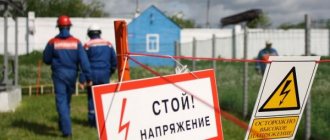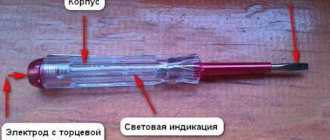Any enterprise always ensures that electrical safety is at the proper level. This is one of the mandatory events that people pay attention to and devote quite a lot of time to. This allows you to protect workers from dangerous and harmful effects caused by electric current. Of course, all enterprises usually develop their own instructions, which spell out all the issues that arise regarding electrical safety.
Consequently, blue-collar professions that require electrical clearance to work are determined directly by the managers of the enterprise. This, of course, also includes the fourth group, which is assigned to workers - electricians. These specialists have to service electrical installations whose voltage is up to and above a thousand volts.
But every worker who deals with electricity, of course, has his own requirements. He is obliged to undergo not only instruction, but also to pass an exam or test, after which he will receive a special certificate, where his electrical safety qualification group will be written, and this will determine the level of work that he will need to perform.
Enterprise electrical safety groups
There are five qualification groups for enterprise electrical safety.
- The first qualification group refers to employees who use electric tools in their work without the need for training (printers, vacuum cleaners, etc.). It is assigned to an employee of the enterprise who holds the position of responsibility for the electrical services of the organization.
- The second qualification group applies to electrical personnel working with electrically driven equipment, as well as electricians and employees who have overstayed their qualification group by more than six months. This qualification is awarded only by a special commission.
- The third qualification group refers to electrical personnel who have the right to service electrical installations with voltages up to a thousand volts.
- The fourth qualification group refers to electrical personnel who have the right to service electrical installations with voltages up to and above a thousand volts, as well as operational personnel for training young employees. This group is needed by an engineering and technical employee in order to be appointed to the position of responsible for the electrical facilities of the organization.
- The fifth qualification group refers to employees holding positions responsible for electrical facilities, and engineering and technical personnel servicing electrical installations with voltages up to and above a thousand volts.
The effect of electric current on the human body
Electric current, passing through the human body, produces thermal, chemical and biological effects, thereby disrupting normal life activities.
The chemical effect of the current leads to electrolysis of blood and other solutions contained in the body, which leads to a change in their chemical composition and, consequently, to disruption of their functions.
The biological effect of electric current is manifested in the dangerous excitation of living cells of the body, in particular, nerve cells and the entire nervous system. Such excitement may be accompanied by convulsions and symptoms of paralysis. In some cases, paralysis of the respiratory apparatus (paralysis of the chest muscles) and paralysis of the heart (muscles of the ventricles of the heart) are possible, causing death. The cessation of heart function under the influence of electric current can be as a result of the direct effect of the current on the heart muscle, when the current passes through the heart area, or as a reflex - due to dysfunction of the central nervous system.
The degree of injury to a person and the severity of the electric shock depend mainly on the value of the current passing through the human body, the path of the current in the human body and the duration of its passage.
The dependence of current values permissible for humans on the duration of exposure is shown in the figure.
Permissible current values for humans depending on the duration of exposure.
1 – alternating current 50 Hz; 2 – direct current.
Electrical safety approval
An admission is a kind of certificate that makes it clear to the inspector that the worker has been trained in something and has the appropriate knowledge and qualifications. It gives a kind of guarantee , as if it communicates that you can trust something to which you have access.
Tolerances vary in different areas of work. Let's look at electrical safety. He has five groups. To assign a fourth group for servicing electrical equipment up to and above 1000 volts, the knowledge requirements increase, and now you need to be able to read diagrams, have organizational skills and experience in conducting instructions, know fire safety rules and be fully aware of how dangerous it is work in electrical installations.
It should be noted that if you bring your document to another organization, then there you will still need to start the whole journey all over again. A permit is issued by an organization for work only on the territory of its production; it will not be valid at any other production site.
We come to the conclusion that this document is permission to perform work, and the larger the group for work, the more responsibility you have both for yourself and for the people around you at work.
Skills of personnel with clearance group number four
When passing exams on the theoretical aspects of professional disciplines, test assignments . The real exam may also include a test part, but an interview with the commission is mandatory for all persons taking the exams.
Control of professional skills in electrical safety consists of conducting an examination test for the qualification group for which the training took place. After passing the examination in the form of an electrical safety test, personnel are allowed to conduct instructions and draw up orders.
Instructions on electrical safety issues are provided by a specialist who has the first group (referring to electrical personnel). Persons with group number four are allowed to service electrical installations up to and above 1000 volts.
Group 4 personnel who will service electrical equipment up to and above 1000 volts must meet the following requirements:
- The volume of knowledge of a vocational school or college.
- A clear understanding of the level of danger of working in electrical installations up to and above 1000 volts.
- Knowledge of fire safety regulations and the use of electrical equipment at the level required for the specific position.
- Skills in reading equipment diagrams, knowledge of what organizational and technical measures need to be taken to ensure the safety of work (when passing the exam for group number three, this may also be asked).
- Skills in instructing personnel, knowledge for safe work, control over work with electricity.
- Ability to provide first aid if a person is struck by an electric shock.
- Ability to train staff in safety and first aid skills.
LECTURE 9. ELECTRICAL SAFETY
Electrical safety is a system of organizational and technical measures and means that ensure the protection of people from the harmful and dangerous effects of electric current, electric arc, electromagnetic field and static electricity.
Electrical installations used in production pose a great potential danger. In addition to electric shock to people, disruption of electrical installations may in some cases be accompanied by a fire or explosion.
The danger of electric shock to people is specific and is aggravated by the fact that it cannot be detected by the human senses: sight, hearing, smell.
Analysis of static data shows that electrical injuries in the overall balance of injuries at work are not high - only 0.5...1%. However, in terms of the number of fatalities, electrical injuries occupy one of the first places, reaching 30...40% in some industries. At the same time, up to 80% of fatal cases occur in electrical installations with a voltage of 127...380 V.
According to the Electrical Installation Rules (PUE), all electrical installations are divided into 2 groups based on voltage: installations with voltage up to 1000 V, inclusive, and over 1000 V.
The largest number of electrical injuries, which usually occur in installations with voltages up to 1000 V, is explained by the fact that these electrical installations are widespread, and in most cases they are serviced by personnel who do not have special electrical training.
<< Back to top | < Previous | Contents | Next > | To the end >>
Practice shows that in most cases when using electrical energy, danger arises due to a violation of the integrity of the insulation of live parts. The state of insulation is significantly influenced by the temperature and humidity of the environment of production premises, the presence of a chemically active environment and a number of other factors.
Thus, when operating electrical equipment, apparatus and instruments, the issues of protecting operating personnel and other persons from the danger of electric shock become of great importance.
The effect of electric current on the human body.
Passing through the human body, electric current has a complex effect on it, which is a combination of thermal, electrolytic and biological effects (see Fig. 1).
The thermal effect of the current manifests itself in burns of certain parts of the body, as well as in heating from high temperatures of other organs, leading to serious functional disorders.
The electrolytic effect of current is expressed in the decomposition of blood and other organic liquids, causing significant disturbances in their physical and chemical composition.
The biological effect of current is manifested in irritation and excitation of living tissues of the body, which is accompanied by involuntary convulsive contractions of muscles, including the muscles and muscles of the lungs.
Fig 1. Classification of the effects of electric current on humans.
The irritating effect of current on the tissues of a living organism, and consequently the involuntary convulsive muscle contractions caused by it, can be direct, when the current passes directly through these tissues, and in some cases - reflexive, i.e. through the central nervous system when the current path lies outside these tissues.
Any of the above effects may result in electrical injury, i.e. damage to the body caused by the action of electric current or electric arc on it.
Electrical injuries can be divided into two types: local electrical injuries and electrical shocks. In approximately 55% of cases, injuries are mixed.
Local electrical injuries are understood as clearly defined local violations of the integrity of body tissues. Most often these are superficial damage, i.e. damage to the skin and sometimes other soft tissues, as well as ligaments and bones. Usually local electrical injuries are cured and performance is restored completely or partially.
Local electrical injuries include electrical burns, electrical marks, skin metallization, electroophthalmia, and mechanical injuries.
Burns are the result of the thermal effect of electric current at the point of contact. Burns account for two-thirds of all electrical injuries, and many of them are accompanied by other types of injuries. There are two types of burns: current (contact) and arc.
An electric burn occurs when current passes directly through the human body as a result of its contact with a live part and is a consequence of the conversion of electrical energy into thermal energy. Moreover, since human skin has many times greater electrical resistance than other body tissues, most of the heat is generated in it. This circumstance is fully confirmed by the Joule-Lenz law:
Q = 0.24 × J2 × R × t (1)
<< Back to top | < Previous | Contents | Next > | To the end >>
where Q is the amount of heat released, kcal;
J – current strength, A;
R – resistance along the path of current flow (resistance of the human body), Ohm;
t – duration of current, sec.
This explains that an electric burn is, as a rule, a burn of the skin at the point of contact of the body with a live part. Electrical burns occur in electrical installations of relatively low voltage - no higher than 1...2 kV, in most cases they are relatively mild and are usually characterized by 1 or 2 degrees (redness of the skin, blistering). Sometimes severe 3rd and 4th degree burns occur (necrosis of the affected area of skin, charring of tissue).
At higher voltages, an electric arc is formed between the current-carrying part and the human body, which causes an arc burn. Arc burning is the result of exposure of the human body to an electric arc with a high temperature (over 3500 °C) and high energy. This burn usually occurs in high voltage electrical installations - above 1000 V and, as a rule, is severe - 3rd or 4th degree burns. An electric arc can cause extensive burns of the body, burning of tissue to great depths, charring and permanent burning of large areas of the body. Often, 3rd and 4th degree burns are fatal.
Electrical marks (current marks or electrical marks) are clearly defined gray or pale yellow spots on the surface of the skin of a person exposed to current. Signs appear in approximately every fifth victim. Electrical signs are usually painless and their treatment ends well.
Metallization of the skin is the penetration into its upper layers of the smallest particles of metal melted under the action of an electric arc. This happens mainly during short circuits, when disconnectors and switches are turned off under load, etc. The damaged area of skin has a rough, hard surface. The color of the affected area usually resembles the color of metal, the particles of which penetrate the skin. The victim experiences skin tension from the presence of a foreign body in it, as well as pain from a burn due to the heat of the metal brought into the skin (melting metal particles have a fairly high temperature - several hundred ° C).
Metallization of the skin is observed in approximately 10% of victims. In most cases, simultaneously with metallization of the skin, electric arc burning occurs, which almost always causes more severe lesions.
Electroophthalmia is an inflammation of the outer membranes of the eyes that occurs as a result of exposure to a powerful stream of ultraviolet rays, which are vigorously absorbed by the body's cells and cause chemical changes in them. Such irradiation is possible, for example, during a short circuit, which is accompanied by intense radiation of not only visible light, but also ultraviolet and infrared rays. Electroophthalmia occurs quite rarely (1...2% of victims).
Mechanical damage is the result of sharp involuntary muscle contractions under the influence of current passing through the human body. Such contractions can lead to disruption of the integrity of the skin, rupture of blood vessels, as well as dislocation of joints, and sometimes even bone fractures. Mechanical injuries are classified as severe injuries that require long-term treatment. They occur relatively rarely - in approximately 3% of victims.
An electric shock is the stimulation of living tissues of the human body by an electric current passing through it, accompanied by muscle contraction.
There are four degrees of electric shock:
convulsive muscle contractions without loss of consciousness;
convulsive muscle contractions with loss of consciousness, but with preserved breathing and heart function;
loss of consciousness and disturbances in cardiac activity or breathing (or both);
clinical death, i.e. lack of breathing and blood circulation.
<< Back to top | < Previous | Contents | Next > | To the end >>
A person in a state of clinical death does not breathe, his heart does not work, painful stimuli do not cause any reactions, the pupils of the eyes are dilated and do not react to light. However, during this period, weak processes still continue in almost all tissues of the body, sufficient to maintain minimal vital activity.
During clinical death, the cells of the cerebral cortex, sensitive to oxygen starvation, begin to die first - after 5...6 minutes. Other organs stop functioning a little later: liver and kidneys after 10...20 minutes; muscular system in 20...30 minutes. If you provide timely assistance to the victim (artificial respiration and chest compressions); then it is possible to restore body functions. Otherwise, the process becomes irreversible and clinical death turns into biological death.
First aid for a victim in case of electric shock
Saving a victim from the effects of electric current in most cases depends on how quickly he was freed from the effects of electric current and how quickly and correctly first aid was provided to him.
When providing assistance to a victim, you must remember that he is a conductor of current while he is in contact with a wire or elements of an electrical installation, and touching him without proper precautions is life-threatening. Therefore, the first action is to quickly turn off the electrical installation that the victim is touching. If the victim is at height, measures must be taken to ensure his safety after disconnection. If the installation cannot be switched off quickly, it is necessary to separate the victim from live parts, taking precautions for your own safety.
First aid measures depend on the condition in which the victim is after freeing him from the electric current. But first of all, it is necessary to create an influx of fresh air, provide him with peace and call a doctor.
If the victim does not breathe, breathes sharply, convulsively, with sobs, or his breathing gradually worsens, it is necessary to perform artificial respiration using one of the known methods and indirect cardiac massage.
Factors influencing the severity of electrical injuries
The danger of exposure to current on the human body depends on a number of factors:
current strength;
exposure time;
current paths in the human body;
type and frequency of current;
individual properties of the victim;
environmental factors;
The resistance of the human body and the amount of voltage applied to it also affect the outcome of the injury, but only insofar as they determine the amount of current passing through the person.
The strength of the current is the main factor determining the outcome of the lesion.
<< Back to top | < Previous | Contents | Next > | To the end >>
There are three threshold current values (GOST 12.1.009-76): palpable, non-releasing and fibrillation currents (Table 1).
Table 1
A person begins to feel the impact of an industrial-frequency alternating current passing through him in the form of a slight tingling sensation already at a value of 0.5...1.5 mA. Large currents cause muscle cramps and unpleasant pain in a person, which increase with increasing current and are distributed over larger areas of the body. So, with a current of 3...5 mA, the irritating effect is felt by the entire hand; at 8...10 mA, the pain sharply intensifies and covers the entire arm, accompanied by involuntary contraction of the muscles of the hand and forearm. At 10...15 mA, the pain becomes barely bearable, and the muscles of the arms are seized by a spasm and they are partially or completely paralyzed. And a person is not able to open his fingers without outside help and free himself from the current-carrying part.
At a current of 25...50 mA, the muscles of the chest begin to undergo convulsive contractions, breathing weakens or stops. There is a narrowing of blood vessels and an increase in blood pressure. With difficulty breathing and weakened cardiac activity, as a rule, a person loses consciousness. Prolonged exposure to such a current can cause cessation of breathing, after which, after some time, death occurs from suffocation. A current of 50...100 mA causes more rapid disruption of the lungs and heart. However, in this case, as with smaller currents, the lungs are affected first (in time), and then the heart.
A current of 100 mA to 5 A with a frequency of 50 Hz extends its irritating effect to the heart muscle located deep in the chest. This phenomenon is very dangerous for human life, since after 1...2 s from the beginning of the current passing through a person, cardiac fibrillation may occur. A current greater than 5 A, as a rule, does not cause cardiac fibrillation. With such currents, immediate cardiac arrest and respiratory paralysis occurs, bypassing the state of fibrillation.
If the effect of the current was short-term (up to 1...2 s) and did not cause damage to the heart (as a result of heating, burns, etc.), then after the current is turned off, the heart, as a rule, independently resumes normal activity. In this case, breathing does not recover on its own and the victim requires immediate assistance in the form of artificial respiration.
It should be noted that when a very large current flows through a person’s body, the mortal danger will be determined not so much by the cessation of breathing and cardiac arrest, but by the destruction of the internal structure of the body’s tissues and deep burns of the body (3rd and 4th degree burns).
The duration of the passage of current through the human body has a significant impact on the outcome of the injury: the longer the current, the greater the likelihood of severe, fatal injury. This is explained by a number of reasons and, in particular, by the fact that over time the current passing through a person increases (due to a decrease in the resistance of the body, caused, in turn, by its heating during the passage of current) and the likelihood of the moment of current passing through the heart coinciding with the vulnerable one increases. for him, a phase of the cardiac cycle.
The path of current in the victim's body plays a significant role in the outcome of the injury. The greatest danger arises when current directly passes through vital organs (heart, lungs, brain). If the current passes through other paths, then its effect on vital organs can be reflexive, i.e. through the central nervous system, due to which the likelihood of a severe outcome is sharply reduced. Since the path of the current depends on which parts of the body the victim touches the live parts, its influence on the outcome of the injury is also manifested because the skin resistance in different parts of the body is different. The most dangerous path is the right hand and feet, because in this case, the largest proportion of the current falls on the heart region compared to other directions of current movement. The least dangerous path is leg-to-leg.
The type and frequency of the current, along with the factors discussed above, have a certain influence on the outcome of the lesion. It has been established that direct current is approximately 4...5 times safer than alternating current with a frequency of 50 Hz, as evidenced by the data given in (Table 1). This is quite convincingly explained by the fact that when alternating current passes through the human body, his body must be rebuilt and each time react to a change in the direction of movement of its electrical charges. Direct current moves in one direction and its effect is manifested mainly in heating the tissues of the human body. However, this statement is true only for relatively small voltages - up to 250...300 V. At higher voltages, the danger of direct current increases.
With an increase in the frequency of alternating current passing through the human body, the total resistance of the body decreases, and, consequently, the magnitude of the passing current increases. Such a reduction in resistance is possible only within frequencies from 0 to 50...60 Hz. A further increase in the frequency of the current is accompanied by a decrease in the danger of injury, which completely disappears at a frequency of 450...500 kHz. The reduction in the risk of electric shock with increasing frequency becomes practically noticeable at a frequency of 1000...2000 Hz. However, currents of such high frequencies remain a danger of burns both in the event of an electric arc and when they pass directly through a person.
The resistance of the human body has a strong influence on the outcome of the injury. It determines, according to Ohm's law, the amount of current passing through the human body. Human resistance is measured within very wide limits. The top layer of skin (stratum corneum) with a thickness of 0.2 mm has the greatest resistance. The condition of the skin significantly affects the resistance of the human body. The resistance of the human body with dry, clean and intact skin, measured at voltages up to 15...20 V, varies widely - 3000...100000 Ohms, and sometimes more. With the subthreshold layer, the body resistance drops to 1000...5000 Ohms, and with complete removal - to 300...500 Ohms.
An increase in the area and density of contact of the human body with current-carrying parts helps to increase the overall conductivity of the body and reduce the transition resistance, which ultimately leads to a decrease in the resistance of the human body. The amount of resistance of the human body is equally influenced by the location of the contacts, since the same person has different skin resistance in different parts of the body.
For various calculations related to ensuring electrical safety, the resistance of the human body is taken to be 1000 Ohms.
The individual properties of the body significantly influence the outcome of the lesion. Physically strong people can more easily tolerate the effects of electric current compared to those suffering from various diseases. The mental state of the victim at the time of the electrical injury is also of great importance. Persons suffering from diseases of the heart, internal secretion organs, nervous diseases, tuberculosis, etc., as well as those in a state of overwork, fatigue or alcohol intoxication, are at greater risk of electric shock.
The state of the environment also affects the mechanism of damage. The presence in the indoor air of a number of production facilities of chemically active and toxic gases that enter the human body reduces the electrical resistance of his body. In humid and damp areas, the skin becomes moisturized, which significantly reduces its resistance.
<< Back to top | < Previous | Contents | Next > | To the end >>
When working in rooms with high ambient temperatures, the skin heats up and increased sweating occurs, while the electrical conductivity of the skin increases.
The influence of environmental conditions is taken into account by the classification of premises (PUE) according to the danger of electric shock to people.
Classification of premises according to the degree of danger of injury to people
electric shock
In accordance with the current PUE, all premises according to the degree of danger of electric shock to people are divided into three classes: premises without increased danger, increased danger and especially dangerous (Table 2).
Premises without increased danger may include ordinary living rooms, offices, laboratories, as well as some industrial premises.
High-risk areas include metal machining shops, stairwells of various buildings with conductive floors, etc.
Particularly dangerous premises include most industrial premises, including workshops of power plants, engineering and metallurgical plants, water pumping stations, battery rooms, galvanizing shops, etc. This also includes areas of work on the ground in the open air or under a canopy.
table 2
The main causes of electric shock to people
The causes of electrical accidents are many and varied. The main ones are:
accidental contact with exposed live parts. This can happen, for example, when performing any work near or directly on live parts: in the event of a malfunction of protective equipment through which the victim touched live parts; when carrying long metal objects on your shoulder, which can accidentally touch uninsulated electrical wires located at a height accessible in this case;
the appearance of voltage on metal parts of electrical equipment (cases, casings, fences, etc.), which under normal conditions are not energized. Most often, this can occur due to damage to the insulation of cables, wires or windings of electrical machines and devices, leading, as a rule, to a short circuit to the housing;
an electric arc that can form in electrical installations with a voltage of over 1000 V between a live part and a person, provided that the person is in close proximity to live parts;
the occurrence of a step voltage on the surface of the earth when a wire is shorted to the ground or when current flows from the ground electrode into the ground (in the event of a breakdown on the body of grounded electrical equipment);
other reasons, which include such as: uncoordinated and erroneous actions of personnel, leaving electrical installations energized without supervision, allowing repair work on disconnected equipment without first checking the lack of voltage and faulty grounding device, etc.
<< Back to top | < Previous | Content
What should personnel with qualification group 4 know?
If an employee has the fourth qualification group, then he not only performs his job duties in working with electrical equipment, but also has the right to train young employees .
It is assigned to personnel performing maintenance and repair of equipment (senior foremen and employees with extensive experience); from administrative personnel are assigned mainly to those who hold the position of responsible for electrical facilities.
It is also assigned to an engineering and technical employee holding the position of responsibility for electrical facilities, if he was appointed to this position by order of the manager. This assignment involves maintaining relevant documentation and conducting briefings, monitoring the serviceability of equipment.
The assignment of the fourth qualification group occurs three months after the assignment of the third qualification category. To improve qualifications from third to fourth, or to extend it, an employee must be sent to study for a period of a month. After completing your studies, you must pass an examination test at the Russian Technical Supervision, and then proceed to perform your official duties.
The result of the examination test is included in the employee’s certificate and in the electrical safety magazine of the enterprise from which he trained.
A representative of the fourth qualification category for electrical safety up to and above a thousand volts works independently with electrical equipment, but he does not have the right to train young employees. He will receive this opportunity only after confirmation of the fifth qualification category for electrical safety up to and above a thousand volts.
The fourth qualification group is renewed annually . And if it is overdue for more than six months, then you will have to be certified again from the second qualification category.
What are the consequences (liability) for lack of electrical safety training?
Responsibility is provided for in Article 9.11 of the Code of Administrative Offenses of the Russian Federation
For officials
— a fine from 2000 to 4000 rubles
For individual entrepreneurs
— a fine from 2000 to 4000 rubles or suspension of activities for up to 90 days;
For organizations
- a fine of 20,000 to 40,000 rubles or suspension of activities for up to 90 days
State inspectors of the Federal State Energy Supervision are authorized to monitor the implementation of legislation, according to Article 23.30 of the Code of Administrative Offenses of the Russian Federation.
Check procedure
A special commission is created to test the electrical safety knowledge of staff members who have the fourth group. It must include at least three officials.
Composition of the Electrical Safety Commission:
- Chairman of the commission (this duty is usually performed by the director of the institution or chief engineer).
- Trade union representative.
- Representative of the labor protection department.
- State inspector of the energy supervision department.
This commission checks the competence of the workers who are responsible for the electrical facilities, their deputies, as well as the labor protection engineer who supervises the electrical facilities. The knowledge of other workers who have access to electrical installations with voltages up to and above 1000 volts is checked by several specially organized commissions. Their composition is approved by the manager responsible for electrical equipment.
Knowledge control is carried out personally, usually in the form of a test. The results of the inspection are entered into a journal and certified by the signatures of the commission members. A successful inspection ends with the issuance of documents certifying the right of each employee to operate electrical installations corresponding to category 4.
Exams for group 4 electrical safety
Electrical Safety Group
You can prepare for certification in specialized training centers or independently.
The Rostechnadzor Commission conducts electrical safety certification for qualification group 4 using tests developed in the Olympox system.
To independently prepare for exams on the Internet, there are online programs that provide paid or free testing.
The OLIMPOX service contains the opportunity to prepare independently using Rostechnadzor tests to pass exams for obtaining permission to work in group 4 in electrical safety.
Main window of the Olympox service
The program consists of two blocks: teaching-controlling and examining.
The teaching and control unit contains a library of normative documents, as well as an archive of technical literature, which is necessary for successfully passing the exam. In addition to the training function, it involves performing an online knowledge test on the issues that the employee has studied. The program contains questions and answers that concern employees of industrial enterprises.
During the final test of knowledge for the group corresponding to admission to work, the student must answer exam papers containing test questions.
Another service for online testing is testsmart.
This site is intended for free online testing of industrial workers and the public on various issues of workplace safety and labor protection. Electrical safety tests were developed in accordance with the questions in the OLIMP:OKS exam cards.
Electrical safety tickets on the Testsmart service
After answering the questions, a link appears, clicking on which the student can see his erroneous answers. Thus, the smart test will allow you to qualitatively prepare for the exam.
Paperwork
Very often nowadays people try to acquire the necessary electrical safety document that would allow them to work on equipment up to and above 1000 volts. But each specialist chooses for himself the path to obtaining such a document for electrical equipment up to and above 1000 volts.
It is easier for someone to buy such a document, but then the question arises: how will he work if he knows nothing in this area. By purchasing, and not receiving, such a document for working on electrical equipment up to and above 1000 volts, the future specialist does not receive any knowledge, which means that if he works according to such a document, he will put everyone around him at risk.
In order to undergo training and pass a normal exam to obtain a document to work with electrical equipment up to and above 1000 volts, you must first study those regulatory documents that relate specifically to this area. You can also find questions for testing or lessons for training on the OLIMPOX website , which is considered an automated system.
All the necessary information about what one must know, how and what is registered for the fourth electrical safety group, which allows working on electrical equipment up to and above 1000 volts, is contained in the brochure of the Rules for Electrical Installations, which is currently in its seventh edition. It was specifically designed for those workers who are going to work on equipment up to and above 1000 volts.
And the most important thing is that those who decide to connect their lives with electrical equipment up to and above 1000 volts should always remember: you should not play with electricity, this is a serious matter and jokes with it can lead to great tragedies.
What documents will the student receive after training?
Based on the results of the training, a student who has successfully passed the knowledge test must receive:
1. Minutes (or an extract from the Protocol) of the meeting of the certification commission for testing knowledge; 2. Certificate of advanced training, executed in accordance with the form established by the letter of the Ministry of Education dated March 12, 2015 No. AK-610/06 “On the direction of Methodological Recommendations.”
Copies of the Certificate and Protocol (or extract from the Protocol) will be sent by email after completing the final test and payment.
Certificates and protocols issued as a result of distance learning do not differ from similar documents received as a result of full-time training. Information about the type of training (full-time or distance learning) is not displayed in the specified documents










